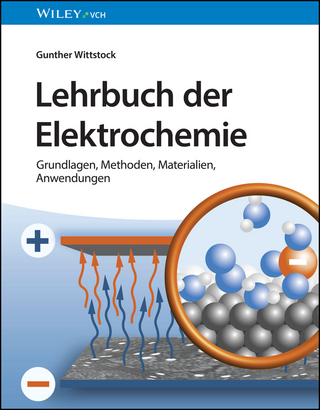
Relativistic Quantum Chemistry
Wiley-VCH (Verlag)
978-3-527-31292-4 (ISBN)
- Titel erscheint in neuer Auflage
- Artikel merken
Written by two researchers, this book presents the fascinating field of relativistic quantum chemistry in a unique, self-contained way. For the first time this new topic is combined in one book, essential for theoretical chemists and physicists.
Prof. Dr. Markus Reiher obtained his PhD in Theoretical Chemistry in 1998, working in the group of Juergen Hinze at the University of Bielefeld. Since this time he has been working in relativistic many-electron theory. He completed his habilitation in Theoretical Chemistry at the University of Erlangen-Nuremberg in the group of Bernd Artur Hess in 2002. From 2003 to 2005, he was lecturer at the University of Bonn and then moved to the University of Jena as Professor for Physical Chemistry in 2005. Since the beginning of 2006 he has been Professor for Theoretical Chemistry at ETH Zurich. Markus Reiher's research interests are diverse and cover many topics in molecular physics and chemistry. His work has been awarded different prizes. Dr. Alexander Wolf studied physics at the University of Erlangen-Nuremberg and Imperial College, London. In 2004, he earned his PhD in Theoretical Chemistry working with Bernd Artur Hess in Erlangen. His PhD thesis elaborated on the generalized Douglas-Kroll-Hess transformation and efficient decoupling schemes for the Dirac Hamiltonian. Afterwards he worked as as postdoc in the group of Markus Reiher at the universities of Bonn (2004) and Jena (2005). His main research interest is relativistic quantum chemsitry and, in particular, two-component Hamiltonians. Since 2006 he has been engaged in financial risk management for various consultancies.
INTRODUCTION
Philosophy of this Book
Short Reader's Guide
Notational Conventions and Choice of Units
PART I: Fundamentals
ELEMENTS OF CLASSICAL MECHANICS AND ELECTRODYNAMICS
Elementary Newtonian Mechanics
Lagrangian Formulation
Hamiltonian Mechanics
Elementary Electrodynamics
CONCEPTS OF SPECIAL RELATIVITY
Einstein's Relativity Principle and Lorentz Transformations
Kinematical Effects in Special Relativity
Relativistic Dynamics
Covariant Electrodynamics
Interaction of Two Moving Charged Particles
BASICS OF QUANTUM MECHANICS
The Quantum Mechanical State
The Equation of Motion
Observables
Angular Momentum and Rotations
Pauli Antisymmetry Principle
PART II: Dirac's Theory of the Electron
RELATIVISTIC THEORY OF THE ELECTRON
Correspondence Principle and Klein-Gordon Equation
Derivation of the Dirac Equation for a Freely Moving Electron
Solution of the Free-Electron Dirac Equation
Dirac Electron in External Electromagnetic Potentials
Interpretation of Negative-Energy States: Dirac's Hole Theory
THE DIRAC HYDROGEN ATOM
Separation of Electron Motion in a Nuclear Central Field
Schrödinger Hydrogen Atom
Total Angular Momentum
Separation of Angular Coordinates in the Dirac Hamiltonian
Radial Dirac Equation for Hydrogen-Like Atoms
The Nonrelativistic Limit
Choice of the Energy Reference and Matching Energy Scales
Wave Functions and Energy Eigenvalues in the Coulomb Potential
Finite Nuclear Size Effects
Momentum Space Representation
PART III: Four Component Many-Electron Theory
QUANTUM ELECTRODYNAMICS
Elementary Quantities and Notation
Classical Hamiltonian Description
Second-Quantized Field-Theoretical Formulation
Implications for the Descriptions of Atoms and Molecules
FIRST-QUANTIZED DIRAC-BASED MANY-ELECTRON THEORY
Two-Electron Systems and the Breit Equation
Quasi-Relativistic Many-Particle Hamiltonians
Born-Oppenheimer Approximation
Tensor Structure of the Many-Electron Hamiltonian and Wave Function
Approximations to the Many-Electron Wave Function
Second Quantization for the Many-Electron Hamiltonian
Derivation of Effective One-Particle Equations
Relativistic Density Functional Theory
Completion: The Coupled-Cluster Expansion
MANY-ELECTRON ATOMS
Transformation of the Many-Electron Hamiltonian to Polar Coordinates
Atomic Many-electron Wave Function and jj-Coupling
One- and Two-Electron Integrals in Spherical Symmetry
Total Expectation Values
General Self-Consistent-Field Equations and Atomic Spinors
Analysis of Radial Functions and Potentials at Short and Long Distances
Numerical Discretization and Solution Techniques
Results for Total Energies and Radial Functions
GENERAL MOLECULES AND MOLECULAR AGGREGATES
Basis Set Expansion of Molecular Spinors
Dirac-Hartree-Fock Electronic Energy in Basis Set Representation
Molecular One- and Two-Electron Integrals
Dirac-Hartree-Fock-Roothaan Matrix Equations
Analytic Gradients
Post-Hartree-Fock Methods
PART IV: Two-Component Hamiltonians
DECOUPLING THE NEGATIVE-ENERGY STATES
Relation of Large and Small Components in One-Electron Equations
Closed-Form Unitary Transformations of the Dirac Hamiltonian
The Free-Particle Foldy-Wouthuysen Transformations
General Parametrization of Unitary Transformations
Foldy-Wouthuysen Expansion in Powers of 1/c
The Infinite-Order Two-Component One-Step Protocol
Toward Well-Defined Analytic Block-Diagonal Hamiltonians
DOUGLAS-KROLL-HESS THEORY
Sequential Unitary Decoupling Transformations
Explicit Form of the DKH Hamiltonians
Infinite-Order DKH Hamiltonians and the Arbitrary-Order DKH Method
Many-Electron DKH Hamiltonians
Computational Aspects of DKH Calculations
ELIMINATION TECHNIQUES
Naïve Reduction: Pauli Elimination
Breit-Pauli Theory
The Cowan-Griffin and Wood-Boring Approach
Elimination for Different Representations of Dirac Matrices
Regular Approximations
PART V: Chemistry with Relativistic Hamiltonians
SPECIAL COMPUTATIONAL TECHNIQUES
The Modified Dirac Equation
"[This text] aims to be a reference to explain the principles and fundamentals in a self-contained, complete and consistent way .... The authors have achieved their stated aims." ( Chemistry World , June 2009)
| Sprache | englisch |
|---|---|
| Maße | 170 x 240 mm |
| Gewicht | 1421 g |
| Themenwelt | Naturwissenschaften ► Chemie ► Physikalische Chemie |
| Schlagworte | Chemie • Chemistry • Computational Chemistry & Molecular Modeling • Computational Chemistry & Molecular Modeling • Computational Chemistry u. Molecular Modeling • Physical Chemistry • Physics • Physik • Physikalische Chemie • Quantenchemie • Quantenphysik u. Feldtheorie • Quantum Chemistry • Quantum Physics & Field Theory • Quantum Physics & Field Theory |
| ISBN-10 | 3-527-31292-7 / 3527312927 |
| ISBN-13 | 978-3-527-31292-4 / 9783527312924 |
| Zustand | Neuware |
| Haben Sie eine Frage zum Produkt? |
aus dem Bereich



